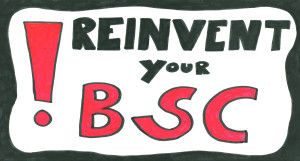 Have you ever considered using a project scorecard?
Have you ever considered using a project scorecard?
Bain research places the Balanced Scorecard as the sixth most used management instrument in the world.
Harvard Business Review labels the Balanced Scorecard as “one of most influential management ideas of the past 75 years” according to.
Yes, the Balanced Scorecard is great. And you can easily use Balanced Scorecard techniques to develop your own project scorecard.
What is a Project Scorecard?
As a scorecard provide a framework for translating the abstract into specific, I find it a very effective instrument to add to the project manager’s toolkit.
A project scorecard helps you to get a better grip on your project: it helps you to clarify project objectives, define KPI’s, measure progress and define actions. It combines a ‘balanced’ (cause/effect) view with a ‘scoring’ (measuring/tracking) view. It focuses on aligning the project goals with individual project members objectives.
In short, a project balanced scorecard breaks the overall projects into specific and measurable chunks.
Useful, wouldn’t you agree?
I also experienced that a project scorecard helps greatly your communication efforts to senior management. They very much like the ‘1 page’ visual overview.
11 Project Scorecard tips
I recently wrote an extensive guide on the Balanced Scorecard. Here’s an overview of the best tips applicable to a project scorecard:
- Don’t rely on the first scorecard book to develop your project scorecard. Knowledge evolves! The first scorecard book was launched in 1996. If you start project scorecard and see project members running around with the original Balanced Scorecard book complete with highlighted paragraphs, something is very wrong.
- Find project scorecard examples. Don’t re-invent the wheel. Reach out to knowledgeable practitioners who developed a project scorecard. Take some time to dig into the subject. Listen to different opinions, build a broad view and make your own mind up, taking into account the specific needs of your project.
- Be ready to manage the change effort. A project scorecard will impact the way your project team will interact, so be ready for a change effort from everyone.
- Don’t hold of communication until the project scorecard is finished. Start right away by communicating the advantages, roles and responsibilities of the project scorecard. Proactive communication will create the necessary buy-in. As a project manager, you are used to communicate, so take advantage of your experience.
- Project scorecard: know your goal. A scorecard can serve many purposes. Make sure you know what you want: is it mainly to communicate to senior management, do you want to have a high level tracking instrument, is the main goal to have a different discussion about the project with the project members,….. Give it some thought before you start and create a project scorecard process that fits your goal.
- Get the words straight. An objective isn’t a measure nor a target. A short overview of the key words and what they mean helps you to avoid confusion in the team. Choose the words carefully and make sure project members stick to them.
- Don’t oversell your project scorecard. Be clear and honest about the expected results. Share the goal you have in mind (see tip 5) and how you want to go about reaching it.
- Define the size of your project scorecard upfront. It’s easy to get carried away. You don’t need a cannon to kill a fly. A small project doesn’t need a complex project scorecard. If you do, you will create frustration. (Just think about a 50 page project charter for a simple 3 week project and you know what I mean)
- The project scorecard is not the end station. So don’t stop. A scorecard cascades your high level project to the next level. But that’s just the first step. Think about connecting your project scorecard to individuals objectives and KPI’s.
- Use your project scorecard to boost strategic thinking. It offers project members a great opportunity to take a step back and reflect on a different time horizon they are used to. Instead of dealing with daily problems, they are challenged to take a long term view regarding the project. You should start slowly and build it up gradually.


